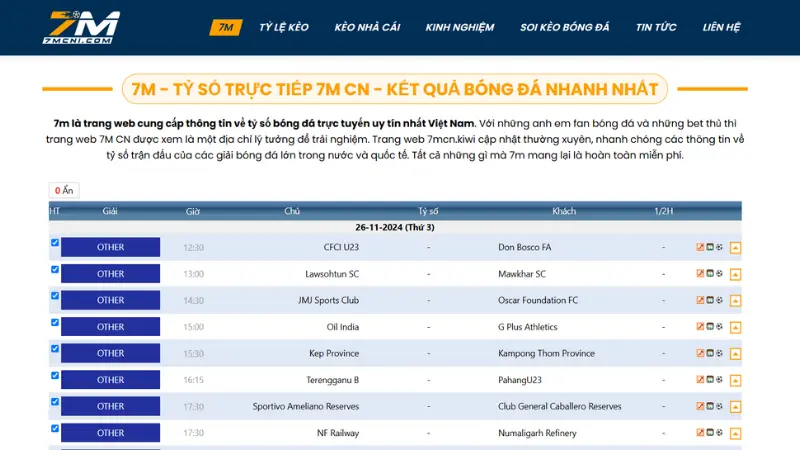7M - Tỷ số bóng đá trực tuyến, KQBD 7MCN chính xác nhất
7M – Trang tỷ số bóng đá trực tuyến hàng đầu Việt Nam
Trang web 7M tự hào là một trong những nền tảng thông tin bóng đá uy tín nhất, với nhiều năm kinh nghiệm hoạt động và đội ngũ nhân viên tài năng. Ngay từ những ngày đầu, tỷ số trực tuyến 7M CN đã đặt sự hài lòng của người dùng lên hàng đầu. Đó là lý do vì sao trang web không ngừng cải thiện để đáp ứng nhu cầu của đông đảo người hâm mộ và dân chơi cá cược. Đội ngũ của 7MCN không chỉ chuyên môn cao mà còn đầy nhiệt huyết, luôn cập nhật nhanh nhất mọi thông tin về bóng đá. Từ những tin tức chính thống đến các tin bên lề thú vị, mọi thông tin đều được biên tập một cách chi tiết và chính xác.
7M – Trang tỷ số bóng đá trực tuyến hàng đầu Việt Nam
Với hàng nghìn lượt truy cập mỗi ngày, trang tin bóng đá 7M đã trở thành một điểm đến quen thuộc của cộng đồng yêu bóng đá. Trang web được ví như một thế giới bóng đá thu nhỏ, nơi người dùng có thể tìm thấy mọi thông tin chỉ trong vài cú nhấp chuột. Dù bạn muốn cập nhật tỷ số, tra cứu thông tin kèo cược, hay đơn giản là tìm hiểu về các đội bóng và cầu thủ, 7MCN luôn sẵn sàng đáp ứng.Link truy cập 7M an toàn
Sự phát triển bùng nổ của bóng đá đã kéo theo sự ra đời của nhiều trang web cung cấp thông tin. Tuy nhiên, không phải tất cả các trang đều uy tín. Để tránh truy cập nhầm vào những địa chỉ kém chất lượng, người dùng nên chọn các đường dẫn an toàn và chính thức của 7MCN. Cách nhận biết link chính thống:- Chỉ truy cập vào các đường dẫn có logo chính thức của tỷ số trực tuyến 7M.
- Ưu tiên những đường link được chia sẻ từ các nguồn đáng tin cậy.
- Lưu lại trang web chính thức để tiện truy cập trong tương lai.
Ưu thế nổi bật của tỷ số trực tuyến 7MCN
7MCN không chỉ dừng lại ở việc cung cấp kết quả bóng đá, mà còn mở rộng ra nhiều lĩnh vực và dịch vụ nhằm đáp ứng tối đa nhu cầu của người dùng. Với hàng loạt tính năng vượt trội, trang tin bóng đá 7M CN là điểm đến lý tưởng cho cả người yêu thể thao và giới cá cược. Dưới đây là những ưu thế nổi bật của nền tảng này.Giao diện dễ sử dụng
7M CN sở hữu giao diện thân thiện, trực quan, cho phép người dùng dễ dàng truy cập và tìm kiếm thông tin. Tất cả dữ liệu được sắp xếp khoa học, giúp việc tra cứu kết quả, lịch thi đấu, tỷ lệ kèo trở nên nhanh chóng. Điều này không chỉ tiết kiệm thời gian mà còn mang lại trải nghiệm mượt mà, tiện lợi cho người dùng trên mọi thiết bị.
Giao diện dễ sử dụng, cho phép người mới truy cập thuận lợi
Đa dạng môn thể thao
Ngoài bóng đá, trang tỷ số trực tuyến 7M cung cấp thông tin về nhiều môn thể thao khác như bóng rổ, quần vợt, bóng chày và cầu lông. Sự phong phú này cho phép người dùng dễ dàng theo dõi các giải đấu yêu thích mà không cần tìm kiếm thêm từ các nguồn khác. Đây là điểm cộng lớn đối với những ai có niềm đam mê thể thao toàn diện.Xem bóng đá miễn phí
Người dùng 7M có thể xem bóng đá trực tiếp hoàn toàn miễn phí mà không cần đăng nhập hay tạo tài khoản. Trang cam kết cung cấp link phát sóng chất lượng cao, hoạt động ổn định trên nhiều nền tảng thiết bị. Đây là một giải pháp tuyệt vời để khán giả tận hưởng trận cầu đỉnh cao mà không tốn kém.Không quảng cáo gây khó chịu
Khi xem bóng đá trên trang tỷ số bóng đá 7M CN, người dùng sẽ không bị làm phiền bởi quảng cáo thừa thãi, bất hợp pháp. Đội ngũ kỹ thuật viên của trang đảm bảo trải nghiệm bóng đá liên tục, mượt mà bằng cách loại bỏ hoàn toàn các quảng cáo gây khó chịu. Điều này giúp người hâm mộ tập trung hoàn toàn vào trận đấu.Hình ảnh HD chất lượng cao
7M CN mang đến hình ảnh full HD mượt mà, đảm bảo chất lượng cao nhất cho mọi trận đấu. Nhờ hệ thống xử lý video hiện đại, trang cam kết không có tình trạng giật lag hay đứng hình, mang đến cho người xem trải nghiệm mãn nhãn và sôi động hơn bao giờ hết.Nhiều link xem trực tiếp, đảm bảo phát sóng liên tục
Trang web cung cấp ít nhất 3 đường link truy cập cho mỗi trận đấu, cùng với các link dự phòng để khắc phục tình trạng nghẽn mạng. Điều này đảm bảo rằng người dùng luôn có thể theo dõi trận đấu liên tục mà không bị gián đoạn.
Nhiều link xem bóng đá trực tiếp, đảm bảo phát sóng liên tục
Hỗ trợ người chơi cá cược
Đối với dân cá cược, trang bóng đá 7M là một công cụ không thể thiếu với tỷ lệ kèo cập nhật liên tục và các bài dự đoán từ chuyên gia. Các thông tin phân tích và thống kê chi tiết trên trang giúp người chơi đưa ra quyết định cá cược chính xác, nâng cao tỷ lệ thắng. Với những ưu thế trên, 7M xứng đáng là một trong những nền tảng hàng đầu cho người yêu thể thao và cá cược. Trải nghiệm đầy đủ tính năng tại đây sẽ mang lại sự tiện lợi và hài lòng tuyệt đối.Những giải đấu bóng đá nổi bật được 7M cung cấp
Trang chủ 7M là điểm đến lý tưởng cho những người yêu thích thể thao, nơi hội tụ thông tin về các giải đấu hàng đầu từ trong nước đến quốc tế. Không chỉ mang đến các giải đấu nổi bật, 7MCN còn bao quát những giải đấu thường niên ít phổ biến hơn. Đây chính là lý do nền tảng này được mệnh danh là “chuyên trang thể thao toàn diện”. Sự phong phú và cập nhật nhanh chóng giúp người dùng dễ dàng theo dõi mọi giải đấu yêu thích, bao gồm:- Giải V-League: Giải đấu quy tụ các câu lạc bộ hàng đầu tại Việt Nam, nơi các đội bóng so tài để xác định nhà vô địch quốc gia.
- Giải Ngoại hạng Anh: Một trong những giải bóng đá hấp dẫn nhất hành tinh, nơi những câu lạc bộ mạnh nhất nước Anh tranh tài với chất lượng thi đấu đỉnh cao.
- Giải Euro: Sự kiện bóng đá hàng đầu châu Âu, nơi các đội tuyển quốc gia danh tiếng thi đấu với tinh thần cạnh tranh mãnh liệt.
- Giải World Cup: Không chỉ là giải đấu phổ biến nhất hành tinh, World Cup còn là biểu tượng của sự kết nối toàn cầu, với sự góp mặt của các đội tuyển mạnh nhất từ các quốc gia.
- Các giải đấu khác: Ngoài các sự kiện lớn, 7M còn cung cấp thông tin đầy đủ về Bundesliga, La Liga, Serie A và nhiều giải đấu khác, đáp ứng mọi nhu cầu của người hâm mộ.

Những giải đấu bóng đá nổi bật được 7M cung cấp
Sự đa dạng này không chỉ giúp bạn dễ dàng tìm kiếm thông tin mà còn mang lại trải nghiệm phong phú khi khám phá các giải đấu mới.Tính năng vượt trội mà 7M CN cung cấp cho hội viên
Để duy trì sự phát triển mạnh mẽ và không ngừng hoàn thiện, 7MCN đã mang đến hàng loạt tính năng vượt trội, đáp ứng nhu cầu của cả người hâm mộ bóng đá và dân cá cược. Những chuyên mục đa dạng và tiện ích dưới đây chính là lý do tỷ số trực tuyến 7M luôn là lựa chọn hàng đầu của người dùng.Dịch vụ soi kèo chuẩn xác
Dành cho những người đam mê cá cược, trang bóng đá 7M cung cấp dịch vụ soi kèo với độ chính xác cao. Dựa trên các bảng số liệu và phân tích chuyên sâu, người chơi dễ dàng dự đoán tỷ số một cách chính xác. Nếu bạn là người mới, 7M CN còn có các bài viết hướng dẫn chi tiết về những loại kèo phổ biến như kèo châu Á, kèo châu Âu và kèo tài xỉu. Đây chính là “trợ thủ” đắc lực giúp bạn nâng cao cơ hội chiến thắng.Livescore 7MCN với tốc độ nhanh
Tính năng livescore của 7MCN giúp người dùng nhanh chóng cập nhật tỷ số các trận đấu bóng đá trên toàn thế giới. Dù bạn muốn biết tỷ số trận đấu giữa đội tuyển Việt Nam và Thái Lan hay một giải đấu ít tên tuổi hơn, 7M đều đáp ứng đầy đủ. Tỷ số được cập nhật theo thời gian thực, đảm bảo chính xác và không sai lệch. Đặc biệt, giao diện trình bày khoa học giúp bạn dễ dàng nắm bắt các thông tin quan trọng như giải đấu, thời gian thi đấu, đội chủ nhà, đội khách, kết quả thắng-thua hoặc hòa.
Livescore 7MCN với tốc độ nhanh chóng và đảm bảo chính xác
Lịch thi đấu 7MCN cập nhật hằng ngày
Với tính năng lịch thi đấu, 7M giúp người dùng dễ dàng theo dõi các trận đấu yêu thích mà không lo bỏ lỡ. Bạn có thể sử dụng chế độ nhận thông báo hoặc nhắc nhở từ trang để tiện theo dõi. Mọi thông tin về ngày giờ, đội thi đấu và giải đấu đều được hiển thị rõ ràng, giúp tiết kiệm thời gian tìm kiếm. Ngay cả những người ít am hiểu công nghệ cũng có thể dễ dàng sử dụng tính năng này.Bảng xếp hạng 7M chi tiết
Bảng xếp hạng của 7MCN là nơi tổng hợp thứ hạng của các đội bóng trên toàn thế giới, bao gồm cả Việt Nam. Người dùng có thể dễ dàng tra cứu tên giải đấu, thứ hạng của các đội tham gia và đánh giá thực lực của đội bóng yêu thích. Đây là nguồn thông tin quý giá giúp người chơi cá cược đưa ra quyết định chính xác khi đặt cược.Kho video highlight hấp dẫn
7M lưu trữ các đoạn video highlight đặc sắc, giúp người hâm mộ không bỏ lỡ những khoảnh khắc đáng nhớ dù không thể xem trực tiếp. Những bàn thắng đẹp, tình huống gây cấn hay các pha bóng ấn tượng đều được tái hiện trọn vẹn. Ngoài ra, kho lưu trữ video cũng là nơi ôn lại những kỷ niệm đẹp từ các trận đấu trong quá khứ.
Kho video highlight hấp dẫn, giúp bạn không bỏ lỡ khoảnh khắc nào
Chia sẻ cẩm nang hữu ích
Ngoài tính năng chính, 7M còn cung cấp các bài viết soi kèo chất lượng cao, được viết bởi các chuyên gia lão làng trong lĩnh vực cá cược. Những cẩm nang này là nguồn tài liệu hữu ích giúp bạn dự đoán tỷ số và hiểu rõ hơn về các loại kèo cược. Đối với người chơi mới, đây chính là bước đệm để học hỏi kinh nghiệm và cải thiện kỹ năng cá cược. Với các tính năng vượt trội trên, 7M CN không chỉ là một trang web cung cấp kết quả bóng đá, mà còn là một hệ sinh thái thể thao toàn diện. Người dùng có thể tìm thấy mọi thông tin cần thiết một cách nhanh chóng, tiện lợi và chính xác.Tin tức thể thao chính xác
Với đội ngũ biên tập viên chuyên nghiệp, trang tin bóng đá 7MCN mang đến các tin tức thể thao nóng hổi và chính xác 100%. Từ đội hình thi đấu, tình trạng chấn thương cầu thủ, chuyển nhượng, cho đến các câu chuyện bên lề sân cỏ, tất cả đều được kiểm duyệt kỹ lưỡng trước khi đăng tải. Đây là nơi bạn có thể tìm thấy mọi thông tin liên quan đến môn thể thao vua. Tin tức thể thao chính xác được cập nhật bởi đội ngũ biên tập viên chuyên nghiệp
Tin tức thể thao chính xác được cập nhật bởi đội ngũ biên tập viên chuyên nghiệp
Tổng hợp câu hỏi thường gặp về 7MCN
7M là một trang web thể thao toàn diện, cung cấp thông tin nhanh chóng và chính xác về trận đấu bóng đá cùng nhiều môn thể thao khác. Để giúp người dùng hiểu rõ hơn về các tính năng và dịch vụ, dưới đây là phần giải đáp những câu hỏi thường gặp nhất về 7M.
Tổng hợp câu hỏi thường gặp về 7MCN
1. Tốc độ cập nhật tin tức thể thao của 7MCN có nhanh không?
7M được đánh giá cao về tốc độ cập nhật thông tin nhanh chóng và chính xác. Trang web cung cấp dữ liệu đa dạng và đầy đủ về tất cả các giải đấu và trận đấu, giúp người dùng nắm bắt kịp thời mọi diễn biến.2. Có thể xem tỷ số trực tuyến 7M CN trên điện thoại không?
Người dùng có thể xem tỷ số trực tuyến trên 7M thông qua nhiều thiết bị di động khác nhau. Hệ thống hỗ trợ hoạt động trên nền tảng iOS và Android, cho phép trải nghiệm thông qua ứng dụng trên điện thoại hoặc truy cập trang web chính thức.3. Xem thông tin trên trang bóng đá 7MCN có mất phí không?
Không. Việc xem tỷ số trực tuyến hay BXH, lịch thi đấu,… trên 7M hoàn toàn miễn phí. Trang web mong muốn tạo điều kiện và hỗ trợ người dùng một cách tối đa khi trải nghiệm, đồng thời đảm bảo chất lượng tốt nhất.4. Sau bao lâu thì tỷ số trên 7M sẽ được cập nhật?
Thời gian cập nhật kết quả bóng đá trực tuyến trên 7M diễn ra rất nhanh chóng. Sau khi đội bóng ghi bàn hoặc trận đấu kết thúc, tỷ số sẽ được hiển thị trên bảng kết quả trong vòng 2-3 giây.5. 7M có cung cấp ứng dụng di động không?
Có, 7M cung cấp ứng dụng di động cho cả hai hệ điều hành iOS và Android, giúp người dùng dễ dàng truy cập và theo dõi thông tin thể thao mọi lúc, mọi nơi.6. Làm thế nào để liên hệ với 7MCN khi cần hỗ trợ?
Người dùng có thể liên hệ với 7M thông qua nhiều kênh như email, hotline, địa chỉ website hoặc fanpage. Nhân viên của 7M luôn túc trực để hỗ trợ và giải đáp thắc mắc của khách hàng.7. Có cần đăng ký tài khoản để sử dụng dịch vụ trên 7M không?
Người dùng không cần phải đăng ký tài khoản để sử dụng các dịch vụ trên 7MCN. Trang web áp dụng chính sách mở, chào đón tất cả mọi khách hàng mà không yêu cầu cung cấp bất kỳ thông tin cá nhân nào.Kết luận
7MCN là điểm đến lý tưởng cho mọi người yêu bóng đá và thể thao. Với những tính năng vượt trội như kết quả trực tiếp, thống kê chi tiết, và tỷ lệ kèo chính xác, 7M không chỉ là nơi cập nhật thông tin mà còn là công cụ hỗ trợ hiệu quả cho cộng đồng cá cược. Đừng quên truy cập trang bóng đá 7M CN mỗi ngày để không bỏ lỡ bất kỳ tin tức hay diễn biến nào!KINH NGHIỆM CÁ CƯỢCXem thêm
Cách chơi cá độ bóng đá không thua – Thủ thuật chiến thắng
Để biết cách chơi cá độ bóng đá không thua, người tham gia cần nhiều...
Poacher trong bóng đá là gì? Điều kiện của Poacher xuất sắc
Poacher trong bóng đá là gì? Đây là thuật ngữ dùng để mô tả một...
Tiki Taka là gì? Đặc trưng của lối chơi Tiki Taka trong bóng đá
Tiki Taka là gì? Tiki Taka không chỉ là một chiến thuật bóng đá mà...
Bóng chính là gì trong bóng đá? Mẹo cược bóng chính hiệu quả
Bóng chính trong bóng đá là một khái niệm quan trọng, đặc biệt đối với...
Kèo chấp 1 trái là gi? Cách bắt kèo luôn thắng
Các thuật ngữ của bet thủ đôi khi làm cho những người chơi ngỡ ngàng...
Kèo xiên là gì? Hướng dẫn tính cược xiên siêu chuẩn xác
Trong cá cược bóng đá, kèo xiên luôn được xem là lựa chọn thú vị...
Nhả xương trong cá độ bóng đá: Bí quyết bỏ qua kèo khó thắng
Nhả xương trong cá độ bóng đá là một chiến lược tinh gọn, tập trung...
Bóng cỏ là gì? Kinh nghiệm bắt kèo bóng cỏ siêu đỉnh
Bóng cỏ, một thuật ngữ quen thuộc trong giới cá cược, đang ngày càng thu...







